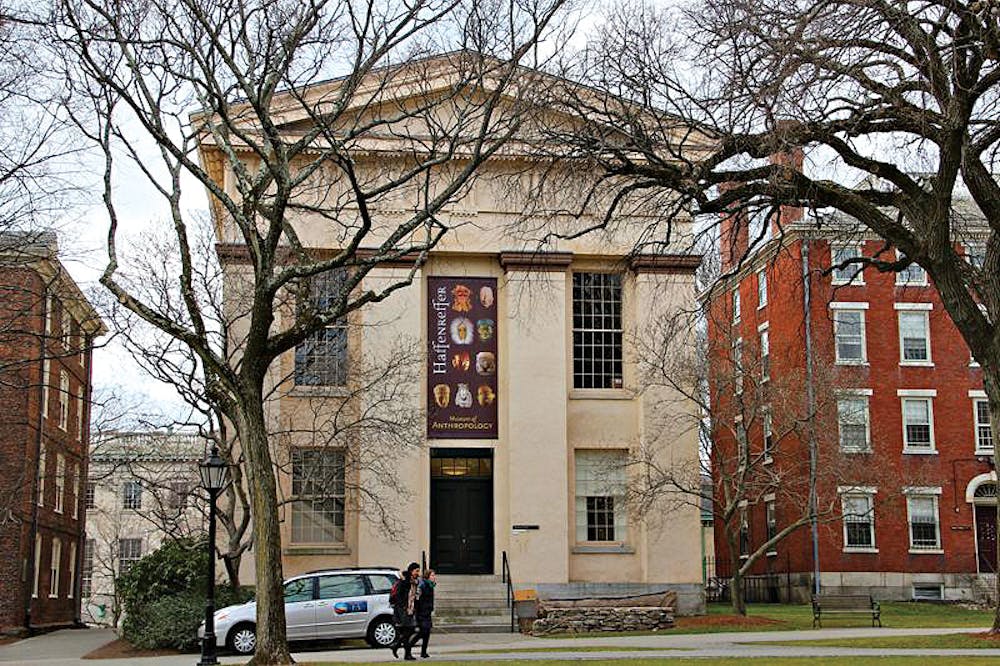A new exhibit, titled “Transient Matter: Assemblages of Migration in the Mediterranean,” opened at the Haffenreffer Museum of Anthropology Feb. 20. The exhibit showcases a collection of objects — including life jackets, blankets and a baby’s bottle — left behind on the island of Lesvos in Greece by migrants on their journey across the Aegean Sea to seek refuge in Europe. Polaroids and original art by the migrants were also featured in the exhibit.
The curators launched “Transient Matter” Thursday with a presentation followed by a question-and-answer session in Friedman Hall and a visit to the exhibit.
The exhibit is curated by Yannis Hamilakis, co-founder of the Decolonial Initiative at Brown and professor of Archaeology and Modern Greek Studies, Darcy Hackley GS, Sherena Razek GS and Ayşe Şanlı GS. Hackley, Razek and Şanlı are doctoral candidates in Archaeology and the Ancient World, Modern Culture and Media and Anthropology, respectively.
The display, which is located in the Manning Hall Gallery, focuses on the experiences of refugees living in Moria Refugee Camp — the largest camp in Europe. “We wanted to show migration as a (phenomenon) that incorporates both dimensions” of loss of life and agency, Hamilakis said. Agency is one of the main themes that the exhibit focuses on, including the ways in which the refugees build their own shelter, find their own food and create schools within the refugee camps.
The exhibit consists of photos, videos and sound clips compiled from multiple trips to Lesvos by Hamilakis and Hackley. It also features polaroid photos taken on a camera lent to the inhabitants of Moria as well as art made by refugees in the camp.
Additionally, “Transient Matter” includes life jackets collected from a “life jacket graveyard” on Lesvos where refugees who arrived by boat discarded these items. The exhibit “is an experiment at the same time (that) it is an attempt to see what happens when objects are not supposed to be shown in a museum,” Hamilakis said.
Another aspect of the exhibit is an interactive map where attendees can trace their own family lineage. The curators asked attendees to “just retrace their own family lineages and histories of migration, which unless you are Indigenous, you have,” Razek said. “There’s something sort of dialectical happening from the objects that we have here,” she added. They are “not normal art objects or … museal objects.”
Hamilakis began working on the project on the Moria Refugee Camp in 2016, and he was joined on a trip to Lesvos by Hackley and another graduate student in 2017. There, they began collecting and curating many of the objects that would ultimately end up in the exhibit.
“We wanted to start from the material dimension,” Hamilakis said. “This material in that local context very often is seen by many regions and authorities as rubbish or trash, as things that need to be cleared away as soon as possible.”
The exhibit as a whole is a collaboration with four charity organizations that each support refugees in different ways.
Hamilakis helped bring “Transient Matter” to the Haffenreffer Museum after he successfully created a smaller version at the Joukowsky Institute, said Emily Jackson, Haffenreffer Museum operations and communications coordinator.
The Haffenreffer then worked with the curatorial team because “typically the curators that we partner with are our faculty and students so they don’t have a significant amount of curatorial experience,” Jackson said. “What they have is the specialized content knowledge.”
The museum staff helped with marketing the exhibit as well as the logistical setup of making the “specialized knowledge fit in a physical space,” Jackson said.
Prior to “Transient Matter,” the Haffenreffer’s past two exhibits, “Drone Warriors: The Art of Surveillance and Resistance at Standing Rock” and “Sacred is Sacred: The Art of Protecting Bears Ears,” were “also very important in a contemporary political context and social-political context, and that’s something that we really value doing and something we’d like to do more of,” Jackson said. “It’s kind of an important part of anthropology to be part of those conversations.”





